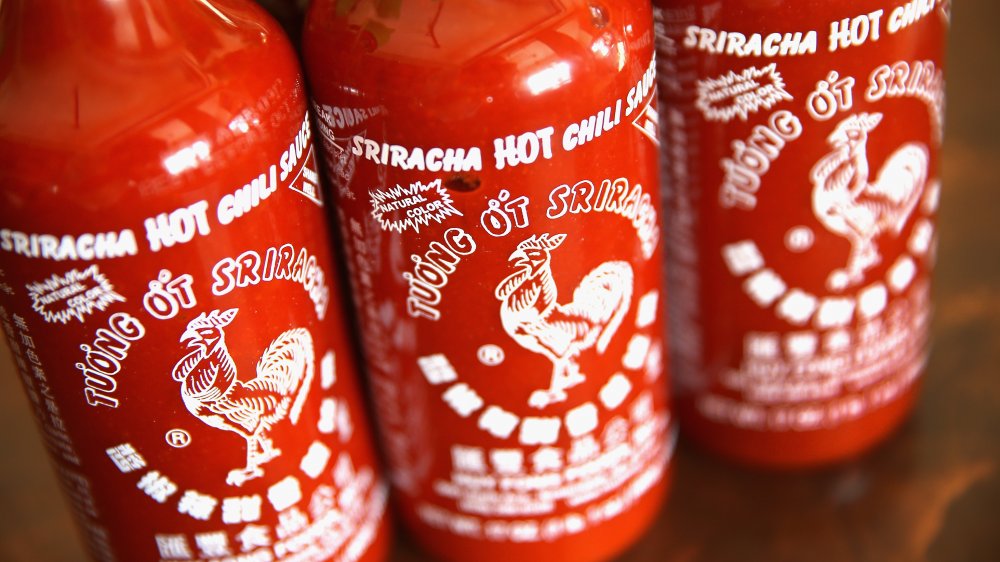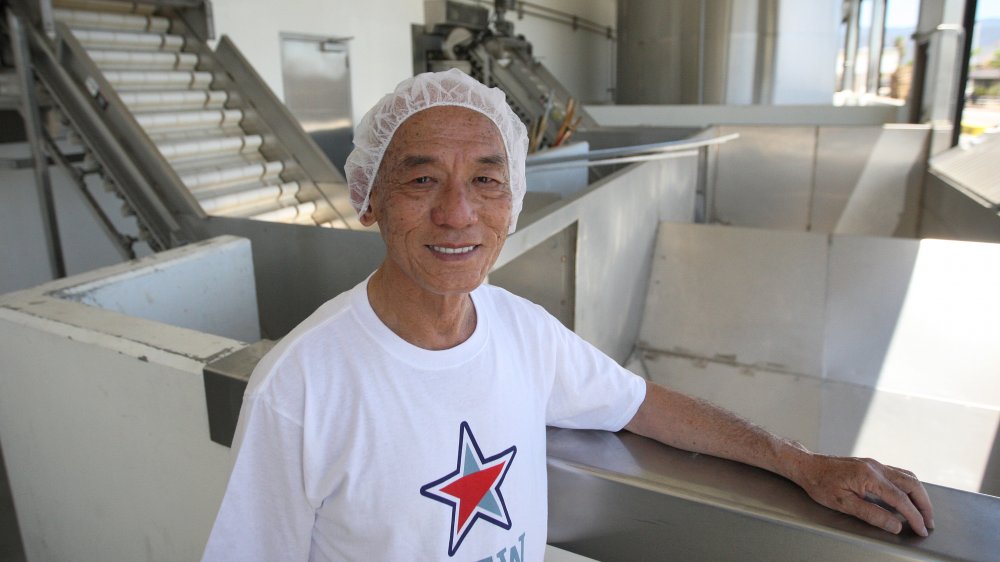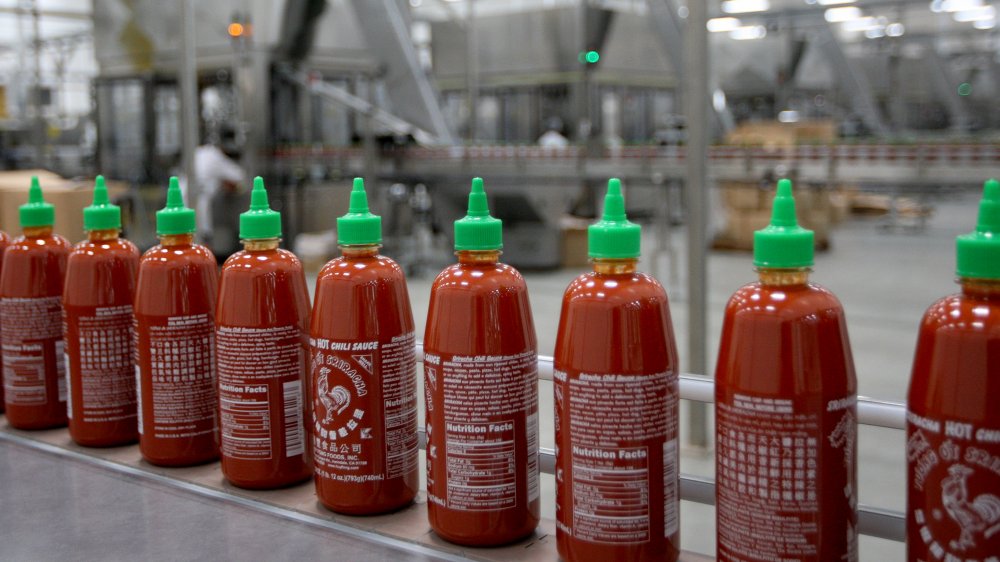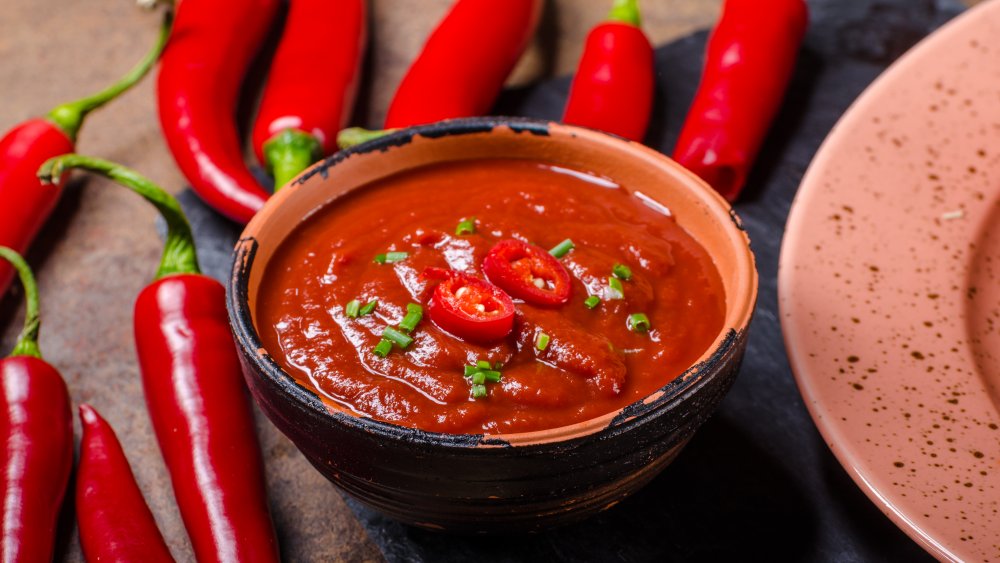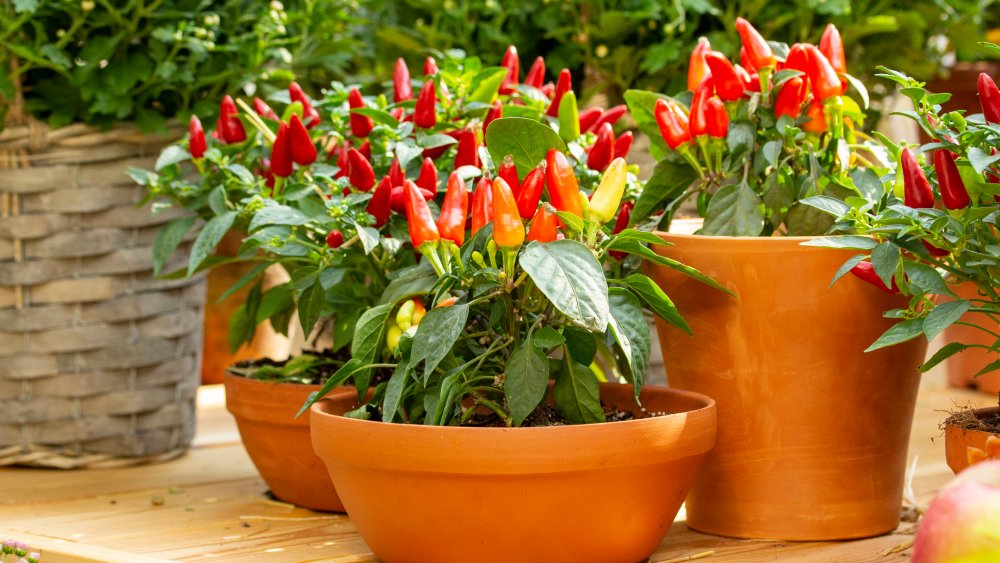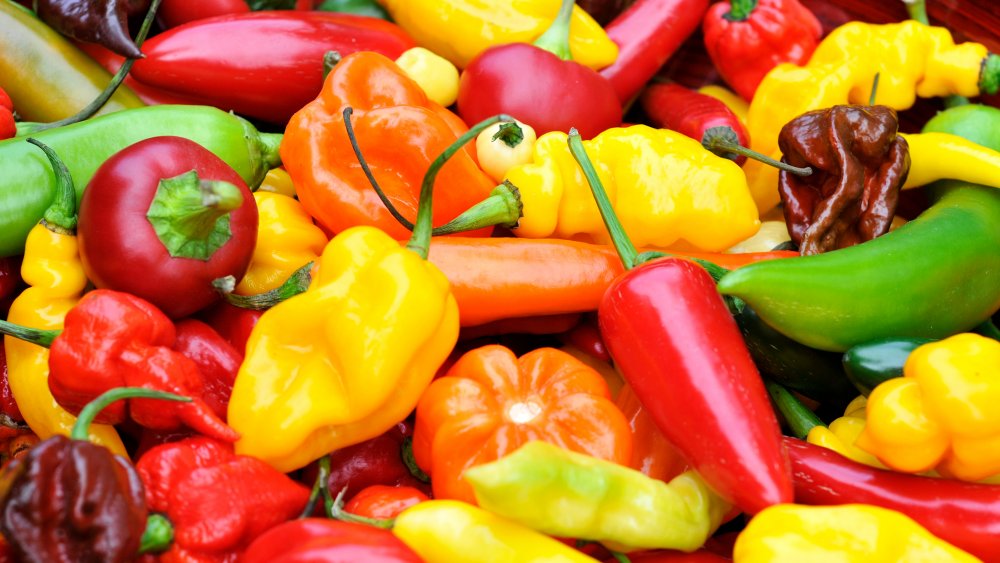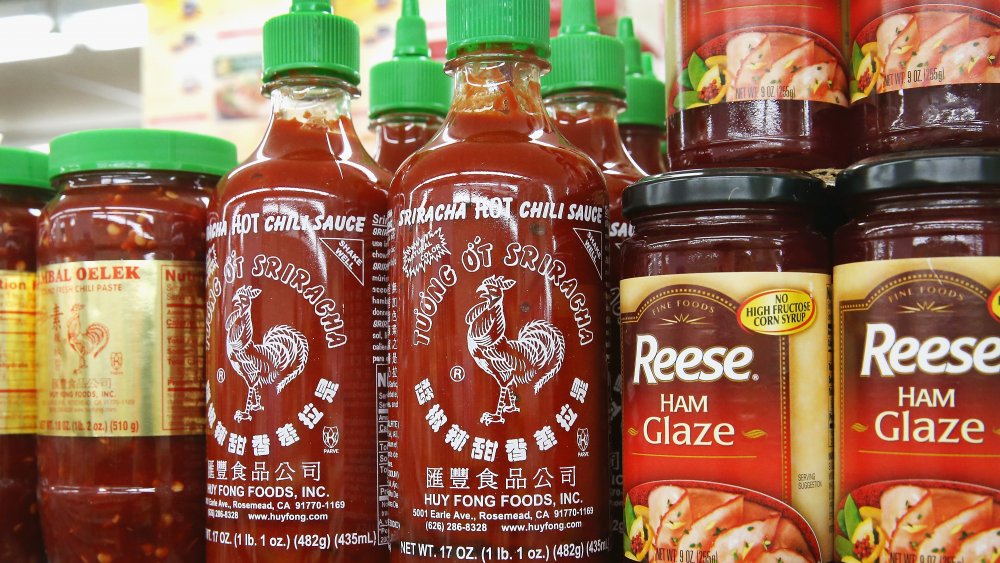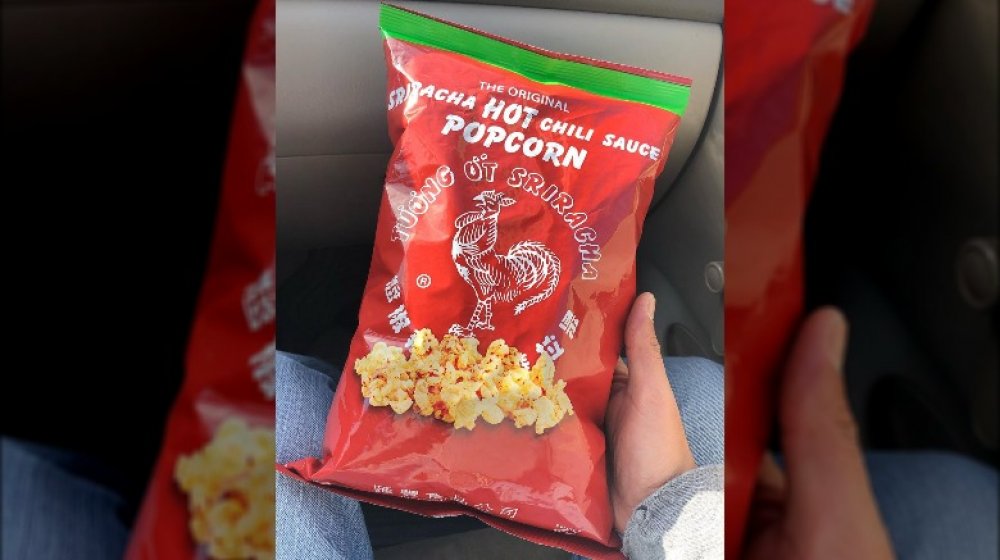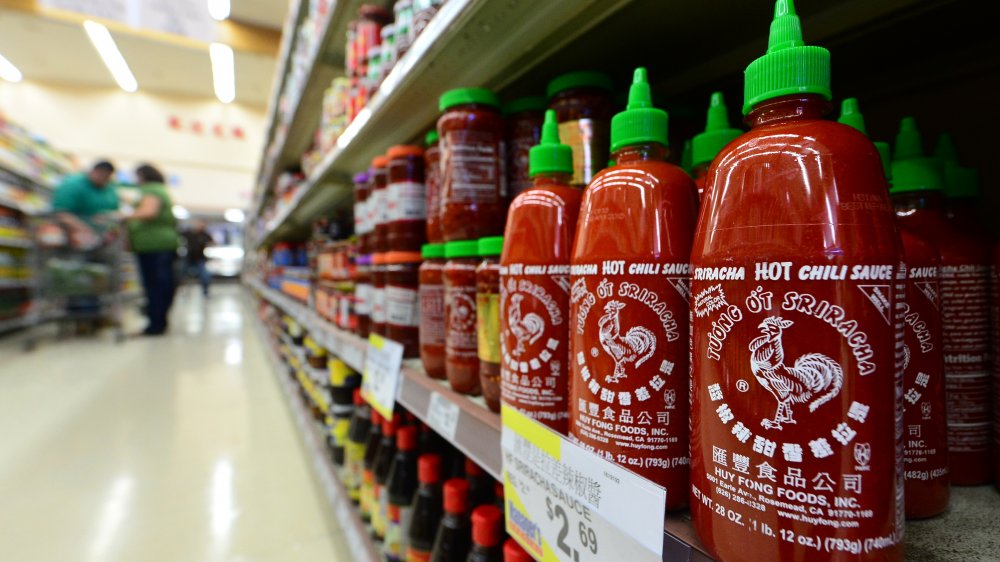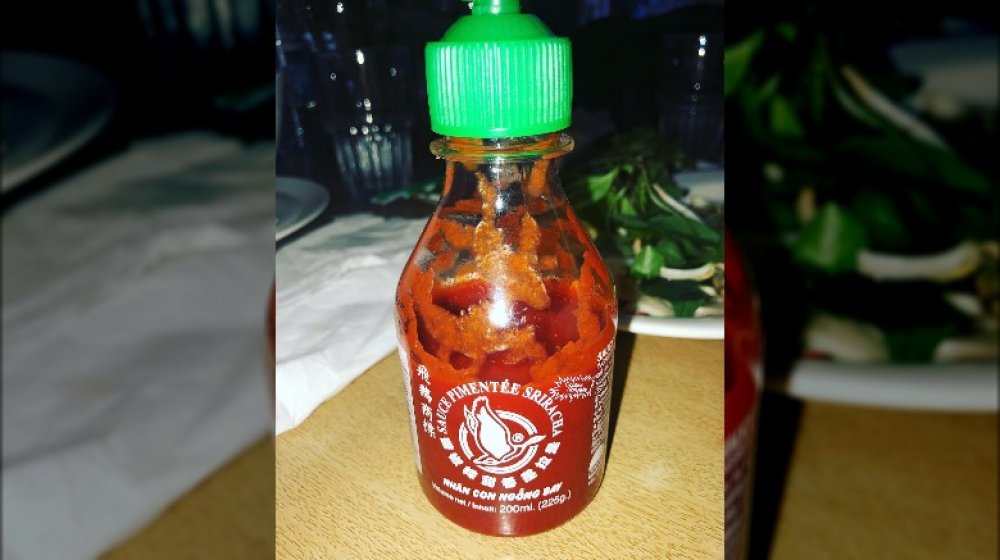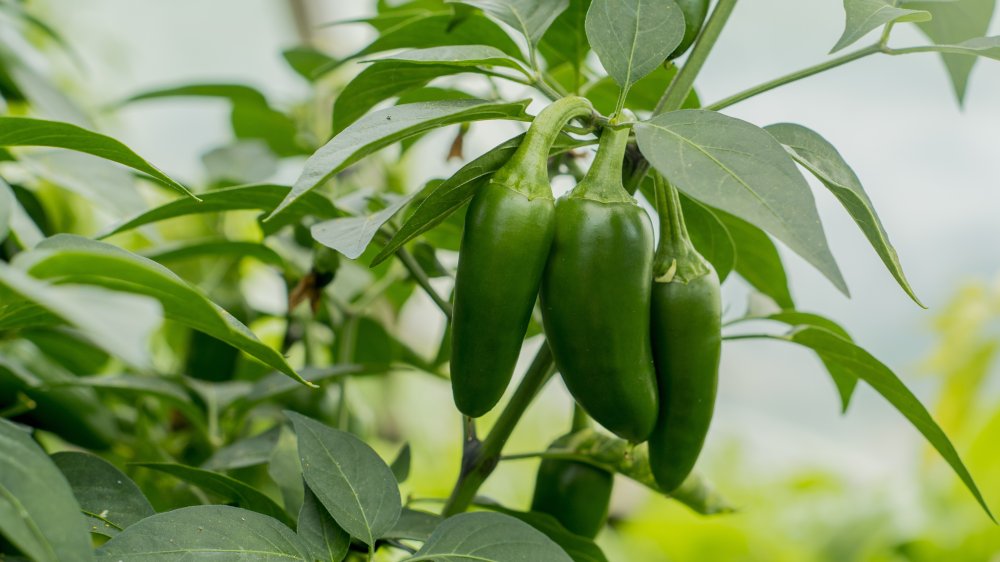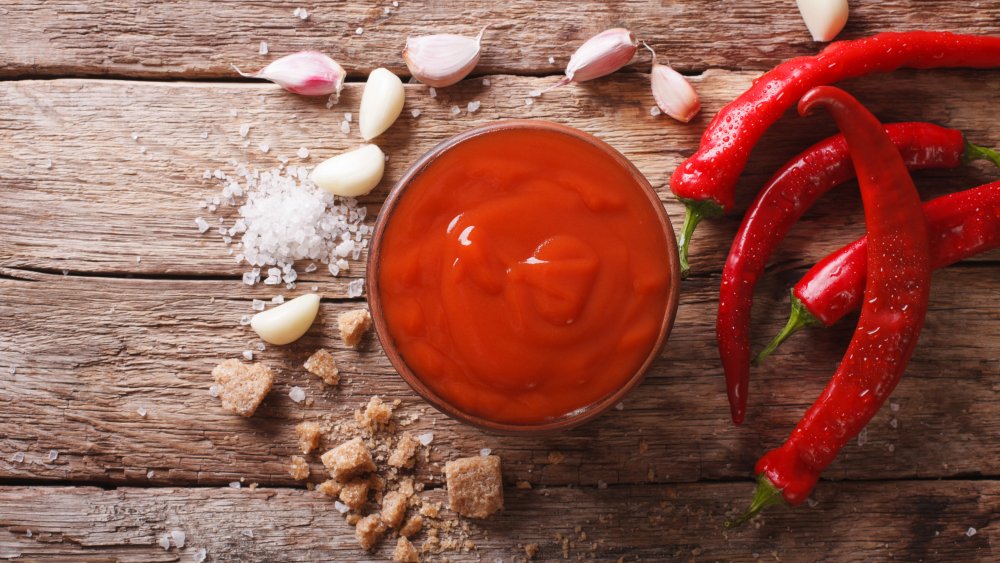The Untold Truth Of Huy Fong Sriracha
Hazarding a guess, we'd say that there's a close to certain chance that you have a bottle of Huy Fong Sriracha sauce on your dining room table — or kitchen counter, or in a cupboard, or wherever — right at this moment. We're right, aren't we? And that's just testament to the sheer ubiquity of this iconic dipping sauce. Despite having literally never been advertised, and despite having only been created in 1980 (almost a hundred years after Heinz began selling ketchup; 75 years after Hellmann's started selling mayo), this spicy little sauce has become one of the world's favorite condiments.
Despite its relatively brief history, Huy Fong Sriracha has a fascinating background and a rich past. Its origins reach around the world, its effects — on body and mind — are genuinely surprising, and its place in the world of home cooking is utterly unique. This is the untold truth of Huy Fong Sriracha sauce.
Huy Fong Sriracha was created to fill a hot sauce void
The founder of Huy Fong is David Tran, a Chinese-Vietnamese migrant who settled in the United States in 1980. When Tran arrived in Los Angeles, he had no job and few prospects. Disappointed by his inability to find a decent hot sauce in L.A., and realizing that fellow Southeast Asian expats were having the same problem, Tran decided to concoct his own version of the Thai sauce known as Sriracha.
Once he had settled on a recipe, Tran began delivering his Sriracha to local markets. But Tran only ever wanted to provide a decent hot sauce to his local community; he never thought of it as a business. "I started the business with my eyes closed," he later told Quartz. "There were no expectations at all."
Today, Huy Fong Foods are a massive company. They own a 650,000-square-foot factory that produces and bottles Sriracha 24 hours a day, six days a week. It is sold around the world, although, because he doesn't keep a detailed record of his distributors' markets, Tran isn't sure where. Over the course of its usual harvest season, the company processes around 100 million pounds of fresh chilies. Basically, they're a big deal.
But Tran hasn't let the success get to him. He reads fan mail, tries out recipes suggested by customers, and has always refused to increase the whole price at which Sriracha is sold — despite the inflation tripling food prices since 1980.
Truckloads of peppers are delivered to the Huy Fong factory each day
So just how is Huy Fong's Sriracha made? Well, in 2016, Eater toured the company's factory in Irwindale, California, to find out the process through which the sauce is created.
The process begins each day when over 21 tons of red jalapeños are delivered to the factory. The peppers are inspected and washed, before being sent into a grinder. While many other condiments cook their ingredients during production, Sriracha skips this step, and the peppers are ground into a mash and piped into industrial mixers. Next, vinegar, salt, and preservatives are added, forming a base for the sauce itself.
After mixing is complete, this base is then sent to a filling station, where it's pumped into storage barrels. These barrels are then stored in the factory's warehouse. To make the sauce, the chili base is extracted from the barrels and sent to another mixing room, where a number of ingredients including garlic and sugar (many of the ingredients remain a secret) are added to the mixture. The sauce is then pumped into those iconic little bottles, which are made in the same factory. In all, 3,000 bottles are produced every hour — which is around 20 million bottles a year.
Huy Fong didn't invent Sriracha
Although Huy Fong is arguably the world's foremost Sriracha brand, the sauce itself actually dates back way farther than 1980. Sriracha originally comes from the city of Si Racha in Thailand. In 2019, NPR sat down with Saowanit Trikityanukul, a 71-year-old woman who recalled making Sriracha sauce with her grandmother when she was a child. "My job was to mix all the ingredients together," she said. "But I wasn't very happy doing it and I didn't really pay attention. I regret that now, because I could have learned a lot."
In fact, it's widely believed that Saowanit's great-grandfather, Gimsua Timkrajang, was the inventor of Sriracha. According to their family legend, Timkrajang would travel around neighboring countries, and eventually brought together a sauce that combined the tastes of sauces he found in each; sweet, salty, and sour.
Because ingredients had to be pickled, peeled, and ripened perfectly, some batches would take weeks to prepare — a far cry from Huy Fong's well-oiled Sriracha machine. Originally, the family made the sauce just for family and friends. Eventually, however, they began selling their own versions in Si Racha itself, and the recipe (which they never patented) soon spread.
In the end, that recipe made its way to David Tran. And although Saowanit is happy for Tran and his success, she does have a bone to pick. "Why do they have to use our name?" she said. "Champagne is one kind of drink. Sriracha is one kind of sauce."
Red jalapeños make all the difference for Huy Fong Sriracha's flavor
Arguably the key ingredient in Huy Fong's Sriracha is the pepper — specifically, the red jalapeño. Most jalapeños you likely come across are green, and there are a few key differences between those and their red siblings.
The main difference is age. Red and green jalapeños are actually the same pepper, but the green versions are younger, being picked earlier in the ripening process. Red jalapeños, for example, have been left to mature on the vine. As a result, the red jalapeño contains more capsaicin, which is the element that gives peppers their spiciness. This means that, generally, red jalapeños are hotter than green ones.
Red jalapeños are often a little healthier than green jalapeños too, since the nutritious vitamins, antioxidants, and capsaicin (yep, it's good for you) have been allowed to grow over time. Red jalapeños also tend to taste sweeter than green jalapeños, making them the perfect choice for Sriracha.
And it's hard to understate just how many Huy Fong get through each year. In 2014, Underwood Ranches, Huy Fong's ex-supplier (but more on that later), were producing 100 million jalapeño peppers per year. That's a hell of a lot of spice.
Huy Fong Sriracha's spice is pretty low on the Scoville scale
The Scoville scale measures the spiciness of various foods. Essentially, it gives a pretty good idea how likely a pepper — or curry, or hot sauce, or basically any other food that uses peppers — is to blow your head off. So where does Huy Fong's Sriracha land on the Scoville scale? Well, according to USA Today, Huy Fong Sriracha ranks anywhere between 1,000 and 2,500 SHU. Keep in mind, the chilies they use are freshly-picked, so there's not a lot of consistency between the heat from one bottle to the next.
This places Huy Fong Sriracha firmly on the lower end of the Scoville scale — but you knew that, didn't you? It's not exactly volcanic. For reference, a bell pepper rates a tiny 0 SHU. A standard jalapeño can range from anywhere between 2,500 and 8,000 SHU, while a serrano pepper will hit up to 22,000 SHU, and a cayenne pepper can land between 30,000 and 50,000 SHU. And that's still just the bottom half of the scale when it comes to the hottest peppers.
Move on up and you'll find peppers like the ghost pepper, which rates at up to 1 million SHU (for the record, that's 400 times hotter than the hottest bottle of Huy Fong); the naga viper, which is 1,382,118 SHU, and the Carolina reaper, which hits 2,200,000 SHU. If you need some help quantifying just how hot that is — it's really, really, really hot.
Huy Fong Sriracha isn't exactly a health food
Everyone knows someone who lathers every meal they make with Sriracha. They just can't help it — so it goes on pizzas, on burgers, on pasta, on salads, on fish, on ice cream, in their morning coffee... Okay, maybe it's not quite that bad. But some people do eat it a lot. Heck, maybe it's you. But here's a question: Should you really be using it that much? Unfortunately, a lot of condiments are kind of bad for you.
According to Refinery29, there's sadly not a lot of good stuff inside Sriracha, with the only macronutrients to speak of being the extraordinarily scant presence of carbohydrates. Sriracha does, however, contain plenty of salt and sugar. One teaspoon-sized serving contains 80 milligrams of sodium and 1 gram of sugar. That's about as sugary as the same amount as ketchup, but almost twice as heavy in sodium. It's also worth noting that most people don't limit themselves to one serving. "It is super important to consider how unrealistic a one-teaspoon serving size actually is," dietitian Tracy Lockwood told Refinery29. She says that most people consume two tablespoons, which contains about 400 milligrams of sodium.
Considering Americans are recommended to eat fewer than 2,300 milligrams of sodium per day, that's not exactly deadly — but it's not an insignificant amount, either. The truth is, if you're drizzling Huy Fong Sriracha on everything you eat, you're probably asking for trouble.
Huy Fong Sriracha has crossed over into a variety of snacks
If you are the kind of person who drizzles Sriracha on everything — and its sodium content hasn't put you off at all — then you're probably gonna like this.
Yes, Sriracha is now a line of snacks. In 2015, Pop! Gourmet Foods partnered with Huy Fong to release a range of Sriracha-infused snacks. Among the new creations were Sriracha popcorn, Sriracha potato chips, as well as croutons, tortilla chips, hummus, and more, all bearing the great taste of your favorite tabletop hot sauce. What's more, the companies also released a powdered form of Sriracha, intended to be used as a spice mixture that can be sprinkled atop pretty much anything — from fried chicken to fries to nachos.
Of course, Sriracha fans have also taken matters into their own hands, by crafting their own spicy snacks. These recipes include chocolate cookies with Sriracha ganache, because sure, okay; and honey Sriracha pretzel knots, which genuinely sound fantastic. Oh, there's also Sriracha peanut ice cream, and for some reason Sriracha lollipops. And finally, somebody created Sriracha bacon-wrapped onion rings, which arguably could be the greatest snack conceived by mankind. Basically — it's a mixed bag. But the whole list has to be seen to be believed.
Eating Huy Fong Sriracha may give your body a feel-good kick
Okay, so we're starting to feel a little guilty for shaming people who pathologically rinse everything they eat and drink with Sriracha. After all, they can't help it — because, more likely than not, they've got a case of the Sriracha munchies.
It might sound ridiculous, but the truth is that Sriracha, like all spicy food, actually gets you high. Kinda. You see, spicy foods don't just make you sweat — they also kick off a chemical reaction that's similar to the one you get when you do exercise. According to the Organic Authority, our bodies release endorphins as a way of helping us deal with the pain of a pepper's scalding spiciness. It's very similar to the release of endorphins that runners describe as a "runner's high." Only those endorphins are released from eating hot sauce and not running a marathon.
Does this mean that we're going to start seeing Srirachaholics Anonymous groups popping up around the world anytime soon? Not so much. But it does mean that, when you eat this stuff, you're giving your body a little feel-good kick... so don't be so surprised when you end up wanting more.
Beware of Huy Fong Sriracha knockoffs
Unfortunately, as is always the way with that dastardly creature we call the free market, Huy Fong's runaway success in the Sriracha industry has inspired plenty of knock-offs and copycats. We're not just talking alternative Sriracha recipes, either — these are 100% bona fide fakes. And let's face it, the knockoff will never live up to the genuine article.
Here's how you can spot a fake bottle of Huy Fong. Many of the fakes feature caps of varying colors, including light blue. Huy Fong, however, will always have a green cap on the bottle. (It's supposed to look like a chili, y'see.) Equally, if that animal on the bottle is anything other than a rooster, run the other way as fast as you can. You've got yourself a Huy Fong imposter.
The cap on the bottle also has to be grooved, so if you don't see those little ridges or the protruding ring at the cap's base, then you're probably not holding the real thing. Equally, the writing on the bottom of the bottle should be laser-etched, rather than heat-stamped, so if there's a blur on those words, throw that stuff away. It won't do you much good.
Huy Fong Sriracha was involved in a multi-million dollar lawsuit
For 28 years, Huy Fong's chili peppers were supplied by a company called Underwood Ranches. This California-based grower joined up with Huy Fong in 1988, at a time in which they only grew around 50 acres of peppers. By 2016, they grew 1,700 acres... all of it for Huy Fong.
In 2017, however, things grew sour between the two companies. During their time in partnership, they had operated under a partly-oral, partly-written agreement that saw Huy Fong pay for the chilies in installments based on Underwood's estimation for their costs. In 2017, however, they failed to renew their agreement. Huy Fong blamed Underwood for ending the partnership out of the blue, while Underwood accused Huy Fong of trying to cut costs via a new legal entity called Chilico — and attempting to poach Underwood's chief operating officer for themselves.
Huy Fong then alleged that it had overpaid Underwood by $1.46 million, and filed a lawsuit for breach of contract. Underwood countersued for $20 million, claiming it had to lay off 44 employees due to business losses.
In 2018, Underwood began producing its own Sriracha sauce. In a post on Twitter, Huy Fong wrote: "Underwood Ranches came out with their own Sriracha Sauce but is suing Hf for damages in excess of $20m. Underwood expects HF to pay back the 'golden goose' that they themselves killed."
In 2019, the dispute came to an end, when a jury awarded Underwood $23 million in damages.
Yes, you can try to recreate Huy Fong Sriracha yourself
Here's a hypothetical, for you: You're desperate for a little Sriracha (that's the endorphins, you see) but the only versions you can find are bogus knockoffs with a name like Hay Fang, Hiy Fung or some other uncreative ripoff. It's obviously not ideal. So how do you go about making your own Sriracha?
Well, if you really do want to produce your own imitation of Huy Fong's masterpiece, you could do worse than this recipe from Chili Pepper Madness. First, you need to get your hands on some red jalapeño peppers. Once you have, you can either ferment them or use them fresh; fermenting will mellow them out a little, but both ways are good.
To ferment the peppers, you want to mix one quart of unchlorinated water with three tablespoons of sea salt. Pour the resulting brine over the peppers (which should be processed in a food processor or finely chopped), then leave the mixture in a jar for at least a week. After enough time, the brine should turn cloudy. You're then wanting to pour the fermented peppers and brine into a pot, before adding garlic, brown sugar, granulated sugar, and vinegar. Simmer that for five to 10 minutes over medium heat, cool it, smooth it in a food processor, strain it, and voila — you've got your very own Sriracha.
See? That wasn't so hard, was it? David Tran, eat your heart out.
